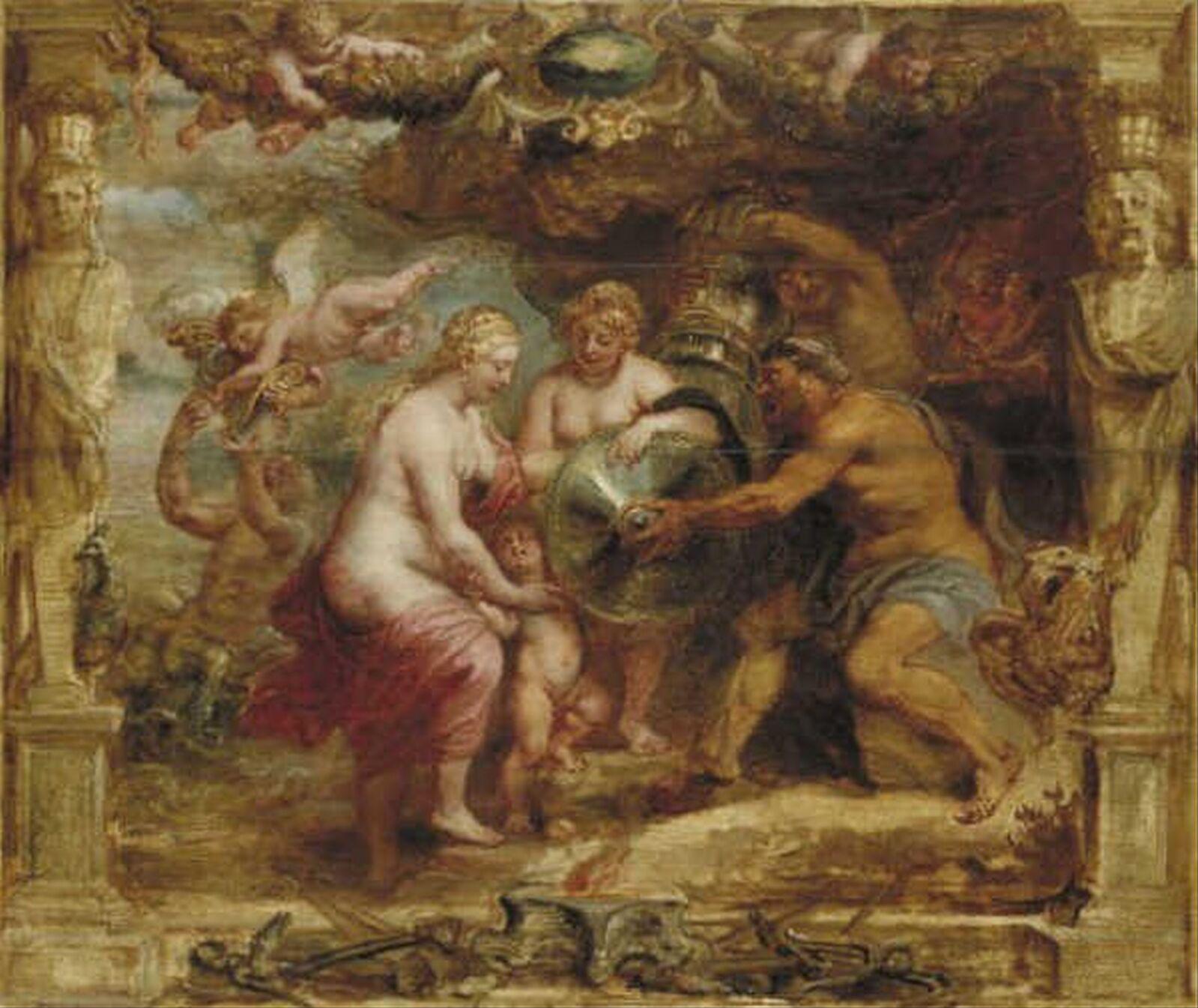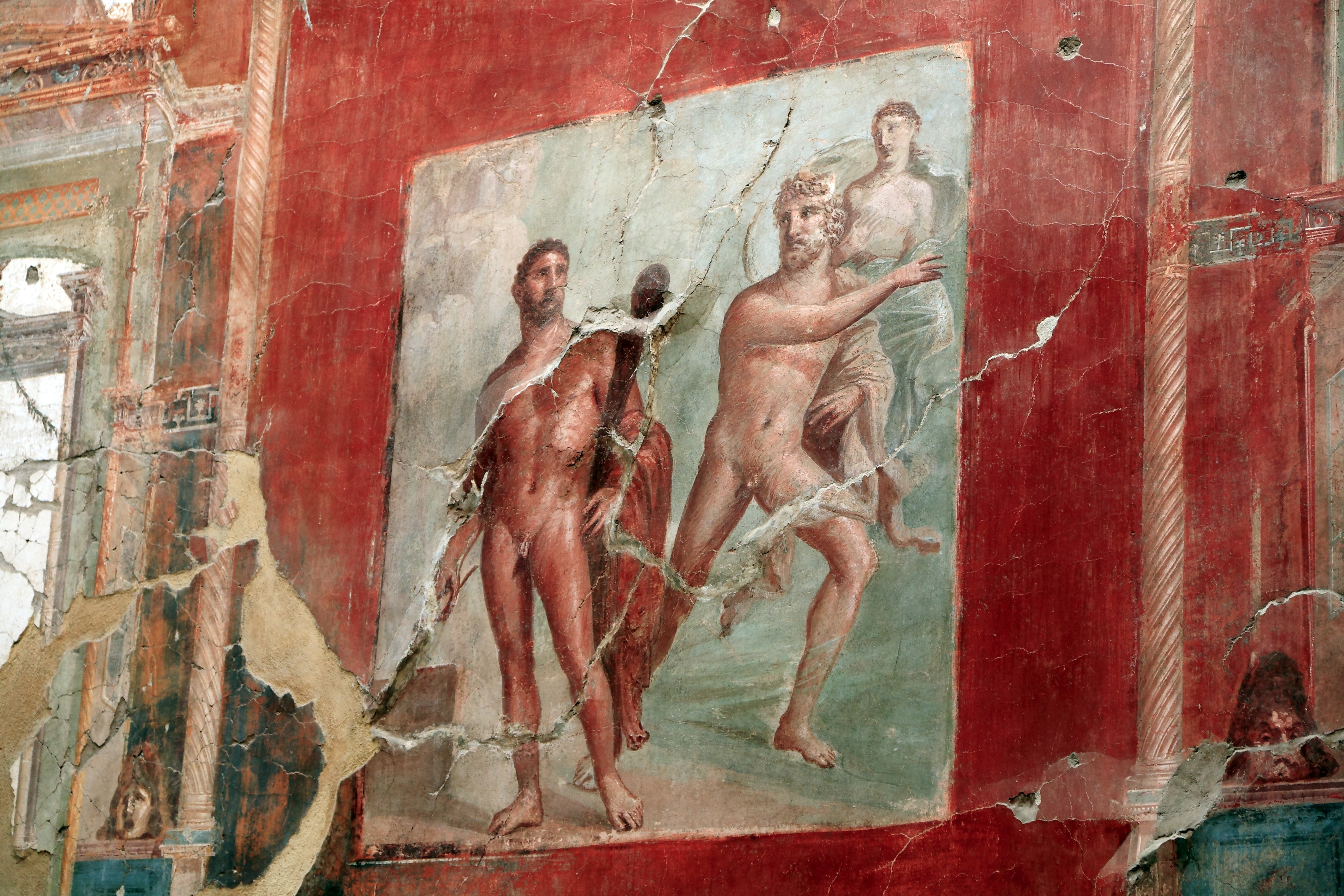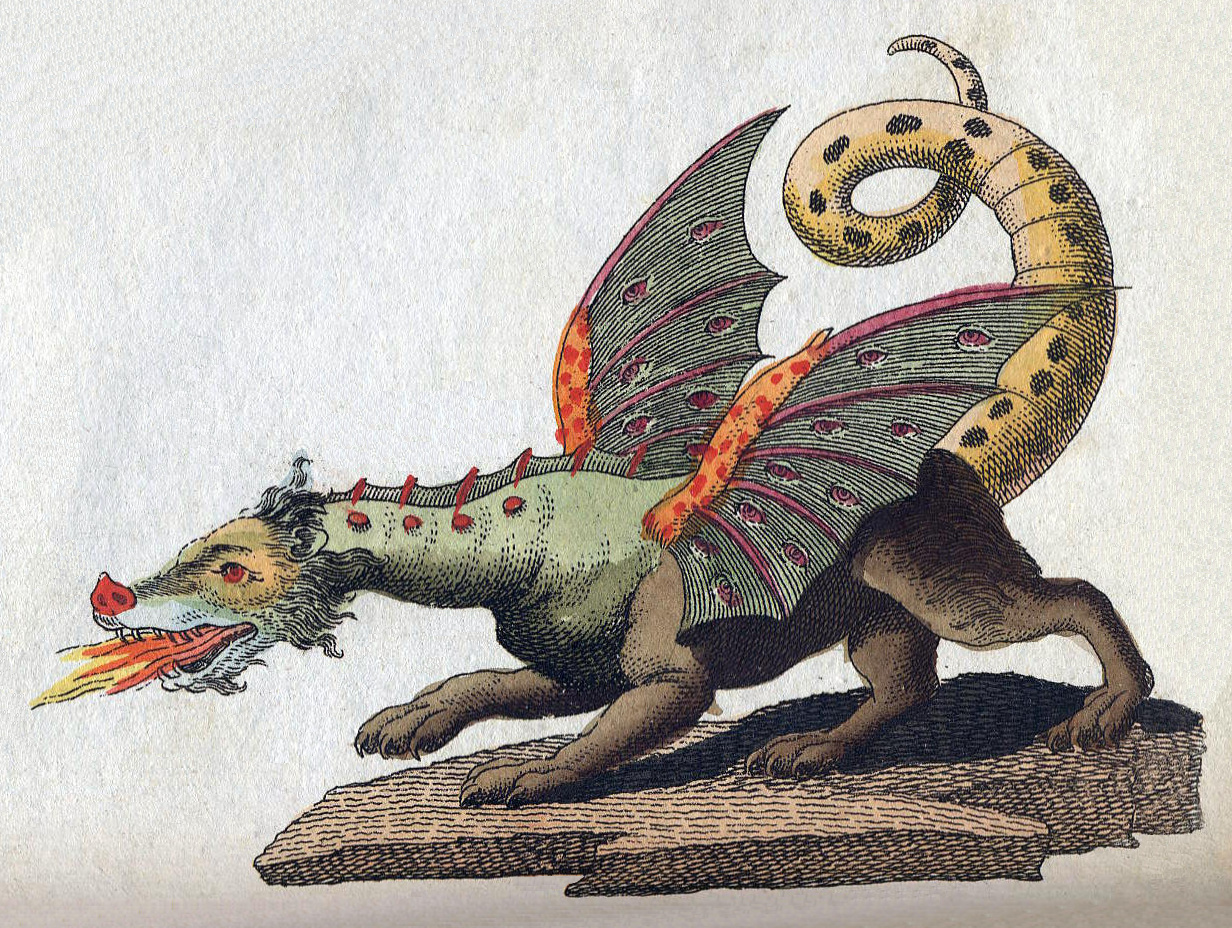|
Cacus
In Roman mythology, Cacus ( grc, Κάκος, derived from κακός, meaning bad) was a fire-breathing giant and the son of Vulcan (Plutarch called him son of Hephaestus). He was killed by Hercules after terrorizing the Aventine Hill before the founding of Rome. Mythology Cacus lived in a cave in Italy on the future site of Rome. To the horror of nearby inhabitants, Cacus lived on human flesh and would nail the heads of victims to the doors of his cave. He was eventually overcome by Hercules. According to Solinus, Cacus lived in a place called Salinae, which later became the location of the Porta Trigemina. According to Evander, Hercules stopped to pasture the cattle he had stolen from Geryon near Cacus' lair. As Hercules slept, the monster took a liking to the cattle and slyly stole eight of them – four bulls and four cows – by dragging them by their tails, so as to leave a trail in the wrong direction. When Hercules awoke and made to leave, the remaining herd made plain ... [...More Info...] [...Related Items...] OR: [Wikipedia] [Google] [Baidu] |
Geryon
In Greek mythology, Geryon ( or ;"Geryon" '''' also Geryone; grc-gre, Γηρυών,Also Γηρυόνης (''Gēryonēs'') and Γηρυονεύς (''Gēryoneus''). '''': Γηρυόνος), son of and , the grandson of |
Vulcan (mythology)
Vulcan ( la, Vulcanus, in archaically retained spelling also ''Volcanus'', both pronounced ) is the god of fire including the fire of volcanoes, deserts, metalworking and the forge in ancient Roman religion and myth. He is often depicted with a blacksmith's hammer. The Vulcanalia was the annual festival held August 23 in his honor. His Greek counterpart is Hephaestus, the god of fire and smithery. In Etruscan religion, he is identified with Sethlans. Vulcan belongs to the most ancient stage of Roman religion: Varro, the ancient Roman scholar and writer, citing the Annales Maximi, records that king Titus Tatius dedicated altars to a series of deities including Vulcan. Etymology The origin of the name is unclear. Roman tradition maintained that it was related to Latin words connected to lightning (), which in turn was thought of as related to flames. This interpretation is supported by Walter William Skeat in his etymological dictionary as meaning ''lustre''. It has be ... [...More Info...] [...Related Items...] OR: [Wikipedia] [Google] [Baidu] |
Caca (mythology)
In ancient Roman religion and myth, Caca or Cacia is the giantess sister of Cacus, the son of Vulcan who stole cattle from Hercules during the course of his western labors. Caca betrays her brother by revealing the location of the cattle to Hercules, who had in turn stolen the cattle from Geryon. According to Lactantius and Servius, she was cultivated as a deity in recognition of her service to the god. In his conceptual approach to Roman deity, Michael Lipka gives Cacus/Caca as one of the examples of divine pairs differentiated by gender but bound by kinship, as Libera was the sister of Liber and Fauna the daughter, sister, or wife of Faunus. Lipka suggests that these deities did not come into existence as pairs, but developed to provide complementary gender balance within their sphere of influence, in this case cattle-raising. Despite the lateness of the only ancient sources that mention her, Caca is probably an older Roman goddess. Servius says she had a ''sacellum'' (shrine ... [...More Info...] [...Related Items...] OR: [Wikipedia] [Google] [Baidu] |
Aventine Hill
The Aventine Hill (; la, Collis Aventinus; it, Aventino ) is one of the Seven Hills on which ancient Rome was built. It belongs to Ripa, the modern twelfth ''rione'', or ward, of Rome. Location and boundaries The Aventine Hill is the southernmost of Rome's seven hills. It has two distinct heights, one greater to the northwest (''Aventinus Major'') and one lesser to the southeast (''Aventinus Minor''), divided by a steep cleft that provides the base for an ancient roadway between the heights. During the Republican era, the two hills may have been recognized as a single entity. The Augustan reforms of Rome's urban neighbourhoods ('' vici'') recognised the ancient road between the two heights (the modern Viale Aventino) as a common boundary between the new Regio XIII, which absorbed Aventinus Maior, and the part of Regio XII known as Aventinus Minor. Etymology and mythology Most Roman sources trace the name of the hill to a legendary king Aventinus. Servius identifies two ... [...More Info...] [...Related Items...] OR: [Wikipedia] [Google] [Baidu] |
Hephaestus
Hephaestus (; eight spellings; grc-gre, Ἥφαιστος, Hḗphaistos) is the Greek god of blacksmiths, metalworking, carpenters, craftsmen, artisans, sculptors, metallurgy, fire (compare, however, with Hestia), and volcanoes.Walter Burkert, ''Greek Religion'' 1985: III.2.ii; see coverage of Lemnos-based traditions and legends at Mythic Lemnos Hephaestus's Roman counterpart is Vulcan. In Greek mythology, Hephaestus was either the son of Zeus and Hera or he was Hera's parthenogenous child. He was cast off Mount Olympus by his mother Hera because of his lameness, the result of a congenital impairment; or in another account, by Zeus for protecting Hera from his advances (in which case his lameness would have been the result of his fall rather than the reason for it). As a smithing god, Hephaestus made all the weapons of the gods in Olympus. He served as the blacksmith of the gods, and was worshipped in the manufacturing and industrial centres of Greece, particularly Athen ... [...More Info...] [...Related Items...] OR: [Wikipedia] [Google] [Baidu] |
Ara Maxima
The Great Altar of Unconquered Hercules ( la, Herculis Invicti Ara Maxima) stood in the Forum Boarium of ancient Rome. It was the earliest cult-centre of Hercules in Rome, predating the circular Temple of Hercules Victor. Roman tradition made the spot the site where Hercules slew Cacus and ascribed to Evander of Pallene its erection. Virgil's ''Aeneid'' tells of Evander attributing the original creation of the Ara Maxima to Potitius and the Pinarii. The original altar burned in the Great Fire of Rome, 64 CE, but was rebuilt and still stood in the fourth century. A tentative identification of a tufa platform in the crypt of Santa Maria in Cosmedin with the foundation of the altar has been made by Filippo Coarelli and other archaeologists. Various references, with Varro as their source, justified the exclusion of women from ceremonies here, or of partaking in the sacrificial meats. The rites at the Ara Maxima were unique within the cult of Hercules in that they were performed ''ri ... [...More Info...] [...Related Items...] OR: [Wikipedia] [Google] [Baidu] |
Evander Of Pallene
In Roman mythology, Evander (from Greek ''Εὔανδρος'' Euandros, "good man" or "strong man": an etymology used by poets to emphasize the hero's virtue) was a culture hero from Arcadia, Greece, who was said to have brought the Greek pantheon, laws, and alphabet to Italy, where he founded the city of Pallantium on the future site of Palatine Hill, Rome, sixty years before the Trojan War. He instituted the festival of the Lupercalia. Evander was deified after his death and an altar was constructed to him on the Aventine Hill. In addition, Strabo mentions a story that Rome was an Arcadian colony founded by Evander. Genealogy Dionysius of Halicarnassus writes that Evander was the son of Apollo and a local nymph of the Arcadians, called Themis. He also mentions that the writers of the early history of Rome called her, in their native language, Carmenta. Strabo writes that the Romans honour the mother of Evander, regarding her as one of the nymphs, and have renamed her Carmenta ... [...More Info...] [...Related Items...] OR: [Wikipedia] [Google] [Baidu] |
Hercules Killing Cacus At His Cave
Hercules (, ) is the Roman equivalent of the Greek divine hero Heracles, son of Jupiter and the mortal Alcmena. In classical mythology, Hercules is famous for his strength and for his numerous far-ranging adventures. The Romans adapted the Greek hero's iconography and myths for their literature and art under the name ''Hercules''. In later Western art and literature and in popular culture, ''Hercules'' is more commonly used than ''Heracles'' as the name of the hero. Hercules is a multifaceted figure with contradictory characteristics, which enabled later artists and writers to pick and choose how to represent him. This article provides an introduction to representations of Hercules in the later tradition. Mythology Birth and early life In Roman mythology, although Hercules was seen as the champion of the weak and a great protector, his personal problems started at birth. Juno sent two witches to prevent the birth, but they were tricked by one of Alcmene's servants and sent t ... [...More Info...] [...Related Items...] OR: [Wikipedia] [Google] [Baidu] |
Hercules
Hercules (, ) is the Roman equivalent of the Greek divine hero Heracles, son of Jupiter and the mortal Alcmena. In classical mythology, Hercules is famous for his strength and for his numerous far-ranging adventures. The Romans adapted the Greek hero's iconography and myths for their literature and art under the name ''Hercules''. In later Western art and literature and in popular culture, ''Hercules'' is more commonly used than ''Heracles'' as the name of the hero. Hercules is a multifaceted figure with contradictory characteristics, which enabled later artists and writers to pick and choose how to represent him. This article provides an introduction to representations of Hercules in the later tradition. Mythology Birth and early life In Roman mythology, although Hercules was seen as the champion of the weak and a great protector, his personal problems started at birth. Juno sent two witches to prevent the birth, but they were tricked by one of Alcmene's servants and sent ... [...More Info...] [...Related Items...] OR: [Wikipedia] [Google] [Baidu] |
Fire-breathing Monster
In mythology and fantasy, a fire-breathing monster is a monster with the ability to shoot fire from its mouth. The concept of a fire-breathing monster is shared by various mythological traditions throughout history, and is also a common element of monsters in the fantasy genre, especially dragons, which are almost always given the ability to shoot fire, or some other type of breath-based attack. The origins of this power may vary, from magic to a biological explanation similar to an organic flamethrower. Mythological origins One of the first monsters described as fire-breathing was the Chimera of Greco-Roman mythology, although these types of monsters were comparatively rare in such mythology, with limited other examples including the Khalkotauroi, the brazen-hooved bulls conquered by Jason in Colchis, which breathed fire from their nostrils, and the cannibalistic Mares of Diomedes, owned by Diomedes of Thrace, which were conquered by Heracles. In addition, the Giant Enceladus wa ... [...More Info...] [...Related Items...] OR: [Wikipedia] [Google] [Baidu] |
Dionysius Of Halicarnassus
Dionysius of Halicarnassus ( grc, Διονύσιος Ἀλεξάνδρου Ἁλικαρνασσεύς, ; – after 7 BC) was a Greek historian and teacher of rhetoric, who flourished during the reign of Emperor Augustus. His literary style was ''atticistic'' – imitating Classical Attic Greek in its prime. Dionysius' opinion of the necessity of a promotion of paideia within education, from true knowledge of classical sources, endured for centuries in a form integral to the identity of the Greek elite. Life He was a Halicarnassian. At some time after the end of the civil wars he moved to Rome, and spent twenty-two years studying Latin and literature and preparing materials for his history. During this period, he gave lessons in rhetoric, and enjoyed the society of many distinguished men. The date of his death is unknown. In the 19th century, it was commonly supposed that he was the ancestor of Aelius Dionysius of Halicarnassus. Works His major work, entitled ( ... [...More Info...] [...Related Items...] OR: [Wikipedia] [Google] [Baidu] |
Roman Temple
Ancient Roman temples were among the most important buildings in Roman culture, and some of the richest buildings in Roman architecture, though only a few survive in any sort of complete state. Today they remain "the most obvious symbol of Roman architecture".Summerson (1980), 25 Their construction and maintenance was a major part of ancient Roman religion, and all towns of any importance had at least one main temple, as well as smaller shrines. The main room ''(cella)'' housed the cult image of the deity to whom the temple was dedicated, and often a table for supplementary offerings or libations and a small altar for incense. Behind the cella was a room or rooms used by temple attendants for storage of equipment and offerings. The ordinary worshiper rarely entered the cella, and most public ceremonies were performed outside where the sacrificial altar was located, on the portico, with a crowd gathered in the temple precinct. The most common architectural plan had a rectang ... [...More Info...] [...Related Items...] OR: [Wikipedia] [Google] [Baidu] |

.jpg)







.jpg)